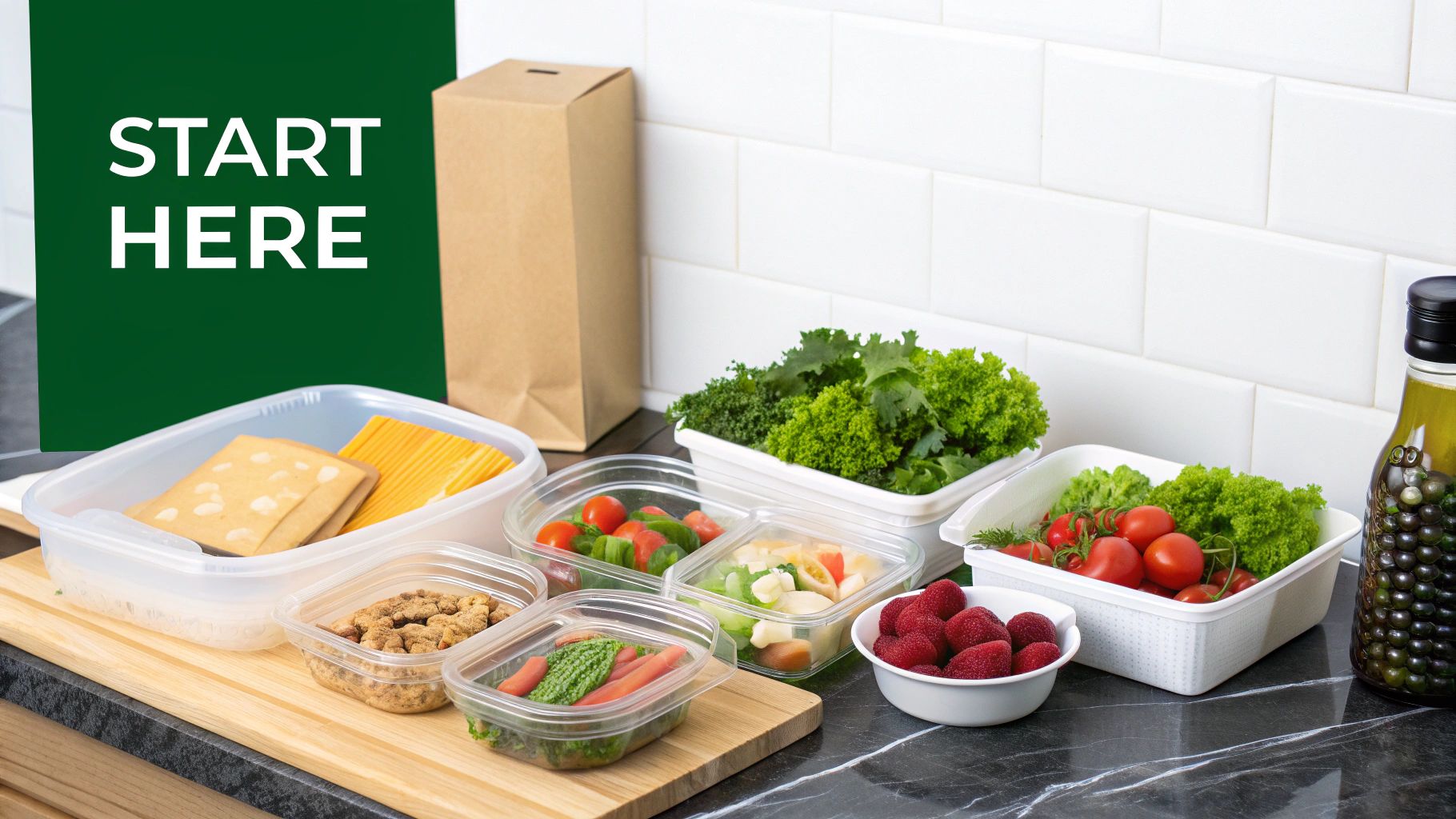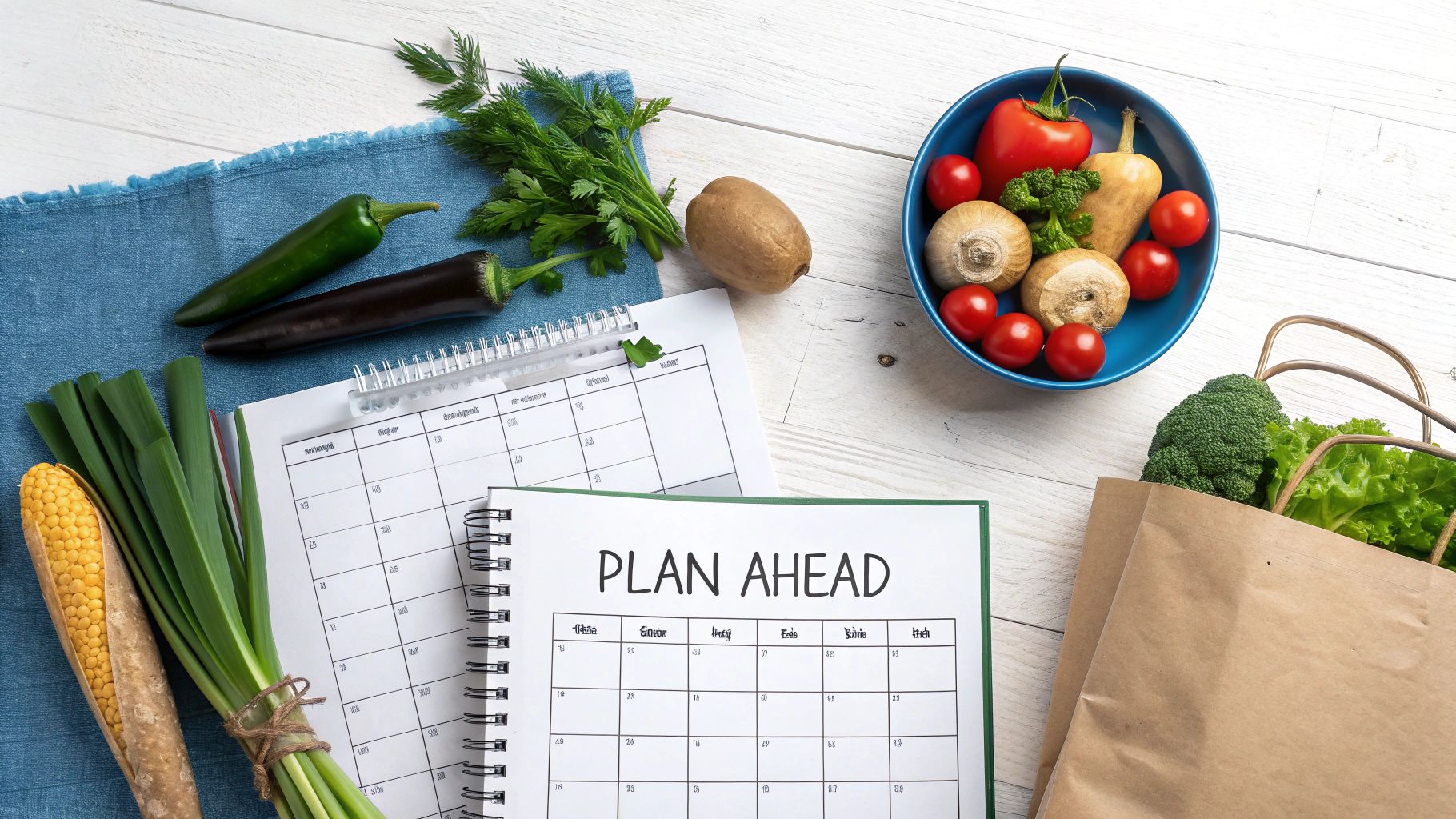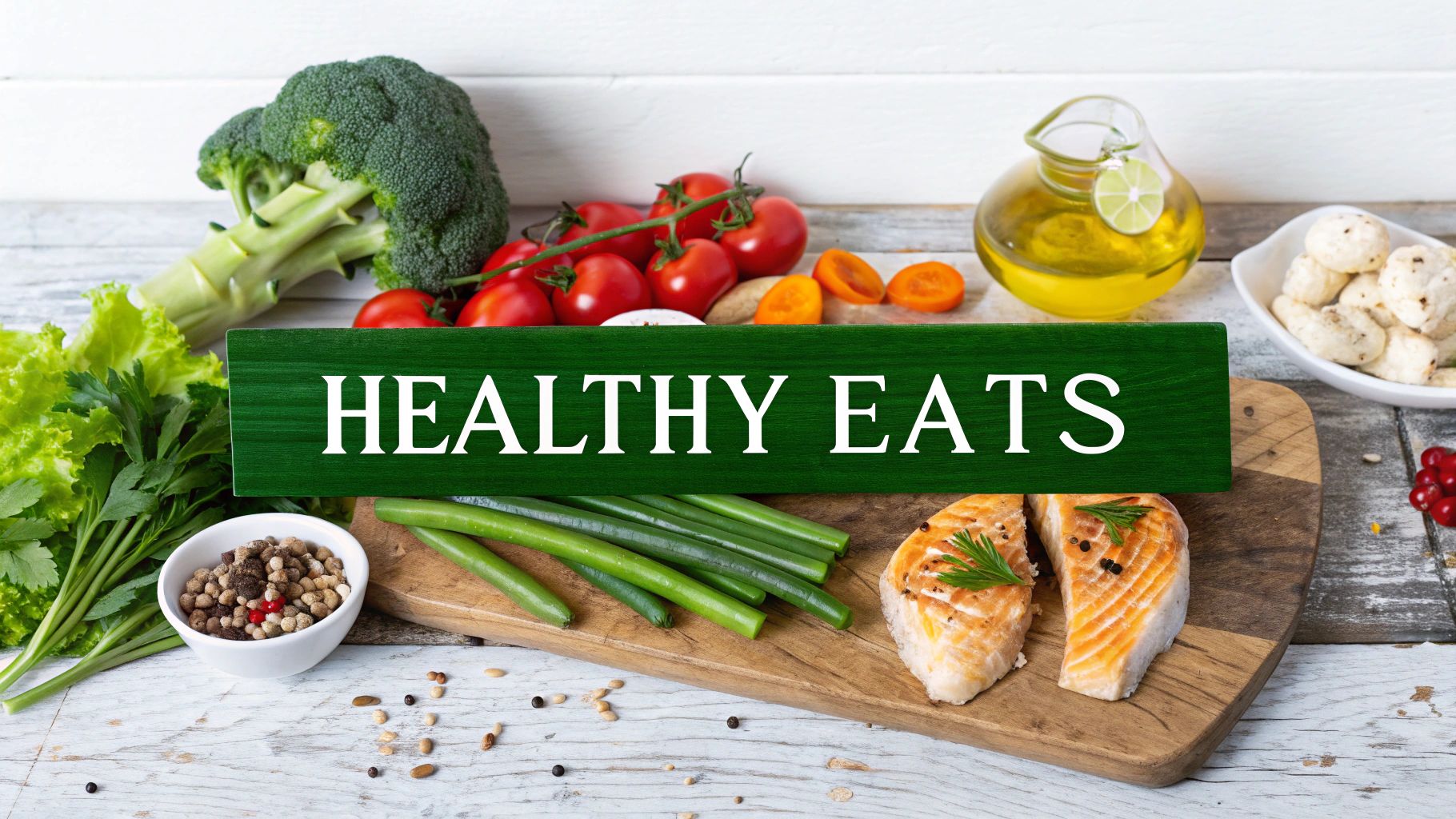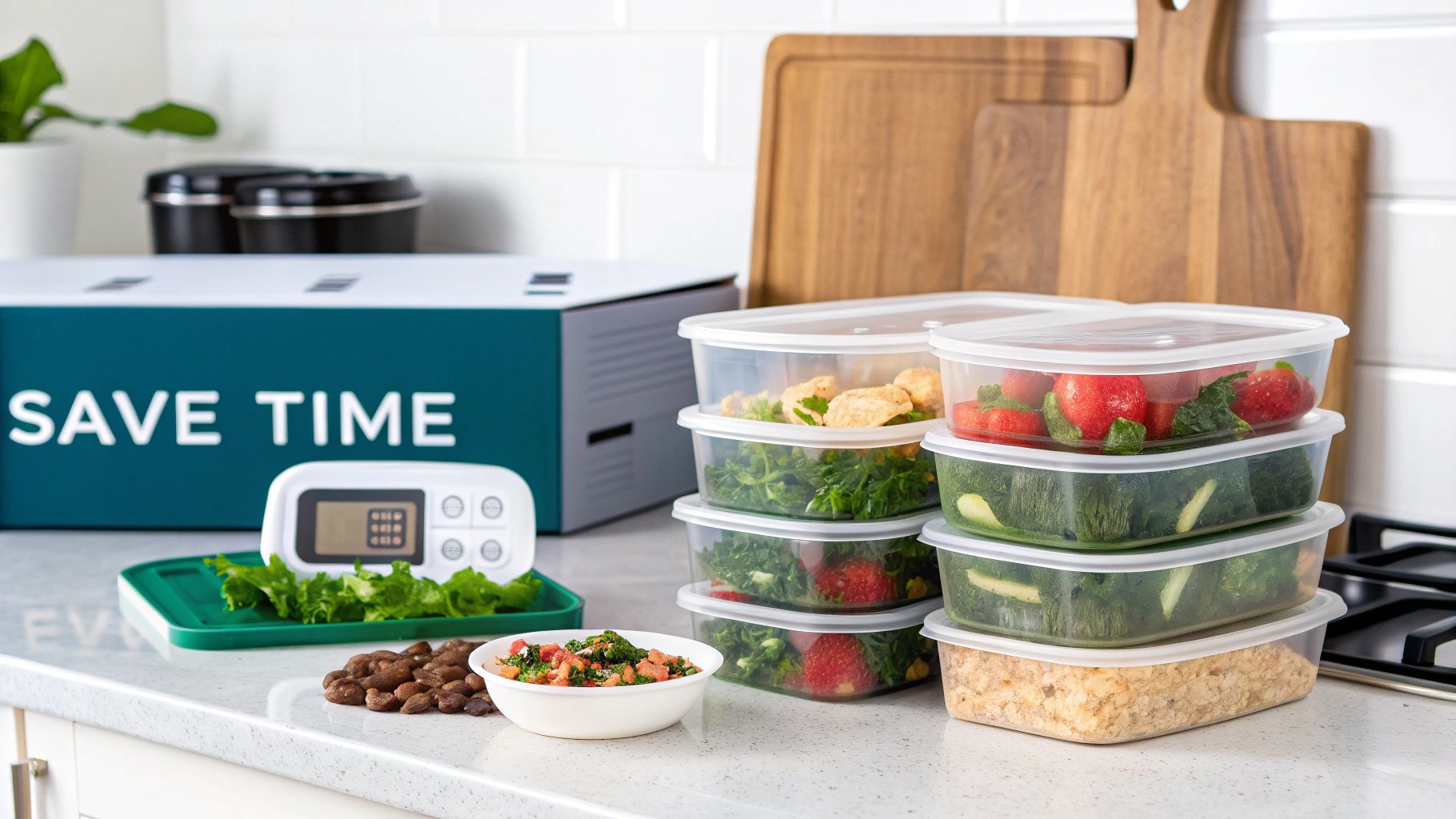Meal Prep for Beginners: Simple Steps to Save Time
Kickstart your kitchen routine with meal prep for beginners. Discover budget-friendly, time-saving tips and transform your meals!
Ready to Simplify Your Meal Planning?
Get personalized meal plans and grocery lists automatically matched to your macro targets.

Meal Prep for Beginners: Simple Steps to Save Time
Why Meal Prep Transforms Beginner's Kitchen Lives

Let's face it, after a long day, the kitchen can feel less like a culinary haven and more like a battlefield. The siren song of takeout or a quick, unhealthy meal is often too tempting to resist. But what if there was a secret weapon, a way to conquer the kitchen chaos and emerge victorious? Enter meal prepping, your culinary knight in shining armor!
This clever strategy is taking the world by storm, especially among busy folks searching for healthy and convenient meal solutions. And the numbers don't lie: the global prepared meals market, currently valued at a whopping $166.62 billion, is projected to skyrocket to $305.68 billion by 2032! That's a CAGR of 7.02%. Intrigued? Delve deeper into this culinary revolution here.
Reclaiming Your Time and Reducing Food Waste
For kitchen newbies, one of the most immediate perks of meal prepping is the sheer amount of time it saves. Imagine: dinner ready in minutes, leaving your evenings free for relaxation, hobbies, or maybe even conquering the world (or at least your to-do list). Plus, meal prepping is a champion of sustainability, significantly reducing food waste. By carefully planning your meals and buying only what you need, you'll minimize the chances of those forgotten veggies turning into science experiments in the back of your fridge. Saving money and the planet? Talk about a win-win!
Portion Control and Healthier Choices
Meal prep is also a secret weapon for portion control, a key ingredient in managing weight and maintaining a healthy diet. Pre-portioned meals eliminate the guesswork and the temptation to overindulge. This means you can savor delicious, satisfying meals without stressing about derailing your health goals. And with healthy meals at your fingertips, you're far less likely to succumb to the lure of unhealthy snacks or less nutritious convenience foods.
Overcoming the Takeout Trap
For many beginners, breaking free from the takeout trap can feel like an uphill battle. The convenience and instant gratification are hard to resist. But meal prep offers a structured, empowering alternative. Think of it as building a positive habit. With each prepared meal, you're reinforcing a healthier pattern and boosting your sense of accomplishment. This shift in mindset, combined with the tangible benefits of meal prep, creates a sustainable, long-term approach to healthy eating.
Essential Tools That Actually Make Meal Prep Easier
So, you're ready to dive into the world of meal prepping? Fantastic! Forget those gleaming, gadget-filled kitchens you see online. Meal prep for beginners doesn't need to break the bank or require a culinary degree. It's all about building a practical toolkit that actually works for you. This means choosing smart tools that fit your budget, your space, and your cooking style.
Must-Have Containers: The Foundation of Freshness
Let's talk containers. Choosing the right ones is like laying the foundation for a house – it's essential! The right containers keep your food fresh, prevent waste, and make grabbing a prepped meal a breeze. To help you navigate the world of food storage, here's a handy comparison:
To help you choose wisely, I've put together a handy comparison table:
Essential Meal Prep Container Comparison: Compare different types of meal prep containers based on durability, features, and price points to help beginners make informed purchases.
| Container Type | Price Range | Durability | Special Features | Best For |
| Plastic | Budget-Friendly | Moderate | Lightweight, stackable | Beginners, everyday use |
| Glass | Mid-Range | High | Oven-safe, no staining/odor | Versatile cooking and storing |
| Stainless Steel | Premium | Very High | Durable, leak-proof | Travel, long-term storage |
Plastic containers are a great starting point for beginners – they're affordable and readily available. Glass containers offer a step up in durability and versatility – perfect for oven reheating and avoiding stains and odors. For the ultimate in longevity and leak-proof security, stainless steel is the way to go, especially if you're often on the move. As you get more into meal prepping, you'll likely find yourself using a mix of all three! For instance, glass is your best friend for reheating meals directly in the oven, minimizing dishes (a meal prepper's dream!).
Essential Tools: Beyond the Container
Containers are just the beginning! A few other key tools will seriously boost your meal prep game. First up: a good set of sharp knives. Dull knives are a safety hazard and make prepping ingredients a chore. Invest in a decent set, and you'll thank yourself later. Naturally, you’ll need a cutting board (or two!). Having separate boards for raw meats and veggies is a smart move for food safety.
Next, a food scale is a game-changer, especially if you're following a specific diet or watching your portions. It takes the guesswork out of measuring and helps you stay on track. Down the line, consider adding a blender or food processor to your arsenal. These are fantastic for whipping up sauces, soups, and smoothies, adding variety and speed to your routine.
Organizational Systems: Streamlining Your Space
Even the best tools won't do much if your kitchen is a disaster zone. Getting organized is key to efficient meal prepping. This might mean dedicating specific drawers or shelves for your meal prep supplies. Shelf risers and drawer dividers are also great for maximizing storage space. Trust me, being able to find what you need quickly will save you tons of time and frustration.
Another pro tip: stock your pantry with staple ingredients. Think dried beans, lentils, grains, and canned goods. These versatile ingredients can be incorporated into countless meal prep recipes, saving you precious shopping time and money. Having these on hand will help ensure your meal prep sessions run like clockwork. Remember, successful meal prepping isn't just about cooking – it's about creating a kitchen ecosystem that sets you up for success!
The Beginner's Blueprint: Meal Prep Step by Step

Want to be the master of your kitchen destiny but don't have a chef's hat (or the time)? No worries! This beginner's guide is your meal prep cheat sheet, bringing order to the chaos and making weeknight dinners a breeze. Get ready to say "goodbye" to last-minute takeout and "hello" to a more organized and satisfying way of eating.
Designing Your Meal Plan: Flexibility Is Key
First things first, think about your schedule and what you like to eat. Are weeknight dinners your nemesis? Do quick breakfasts feel like a distant dream? Focus your meal prep on the meals that stress you out the most. This targeted approach is all about maximizing your time and effort – no wasted energy here!
Choose recipes that make you happy and fit your lifestyle. Meal prepping shouldn't be a punishment! Picking foods you enjoy is the secret to making this a habit you can actually stick with.
Creating Your Shopping List: Avoiding Waste and Forgotten Items
Got your recipes? Great! Now, make a detailed shopping list organized by grocery store sections. This keeps you from wandering around like a lost puppy and ensures a single, efficient trip. List exact quantities to avoid buying too much and minimize food waste.
Before you hit the store, check your pantry and fridge. You might be surprised by what you already have! This not only saves you time and money, but it’s also good for the planet. Speaking of which, did you know that changing habits at home is trending? In the U.K., over 40% of adults spent more time on meal prep during the pandemic, with nearly a quarter planning to keep it up afterward. Check out the stats here.
Mastering Prep Day: Kitchen Efficiency Techniques
Prep day doesn't have to be an all-day affair. Batch similar tasks, like chopping all your veggies at once. Think assembly line efficiency – it's a game-changer. Having the right kitchen tools helps too! And if you're thinking of upgrading, check out this guide on kitchen faucet installation.
Batch Cooking Methods: Shortcuts Without Sacrificing Quality
Pick batch cooking methods that work for your recipes and equipment. Roasting a huge pan of vegetables, for example, is super easy and effective. Cooking a big pot of grains like quinoa or rice provides a versatile base for tons of meals. These staples can be mixed with different proteins and sauces throughout the week.
Ingredient Maximization: From Leftovers to New Creations
Think beyond individual recipes. How can ingredients be used in multiple meals? Roasted chicken can star in salads, sandwiches, or tacos. This minimizes waste and keeps things interesting for your taste buds. This mix-and-match approach turns meal prep into a culinary adventure!
Adapting to Your Lifestyle: From Weeknight Quick Preps to Sunday Sessions
Meal prepping isn’t a one-size-fits-all thing. Adapt it to your life. Short on time? A 30-minute weeknight prep session focusing on a few key components can work wonders. Prefer a more comprehensive approach? A Sunday session might be your jam. Find a rhythm that’s manageable and sustainable, and turn meal prep for beginners into a rewarding routine.
Foolproof Recipes Designed for Meal Prep Success

Now that you've got your meal prep plan in place, let's get to the good stuff: the food! Starting out? Simplicity and versatility are your best friends. Skip the fancy restaurant dishes and embrace delicious, healthy basics that can be mixed and matched throughout the week. This not only saves precious time, but also keeps your taste buds happy and prevents meal boredom.
Beginner-Friendly Meal Prep Formula
Ditch the rigid recipes and think of meal prepping as a choose-your-own-adventure. Think flexible templates where you can swap ingredients based on your cravings and what's on sale at the supermarket. This makes the whole process way less scary and much more adaptable to, well, real life. Food science and meal prep pros have figured out the winning ingredient combos: proteins that stay juicy, veggies that stay crisp, and flavors that actually get better after a few days in the fridge.
To kick things off, here’s a simple formula you can use to build your own meal prep masterpieces:
We've compiled a handy guide to get you started. It outlines a structured approach to building balanced meal prep combinations with mix-and-match components:
Beginner Meal Prep Formula Guide: A structured approach to building balanced meal prep combinations with mix-and-match components
| Base (Grain/Starch) | Protein | Vegetables | Flavor Boosters | Storage Life |
| Quinoa | Roasted Chicken Breast | Broccoli, Carrots | Lemon Herb Marinade | 3-4 days |
| Brown Rice | Baked Salmon | Asparagus, Bell Peppers | Teriyaki Sauce | 2-3 days |
| Sweet Potato | Black Bean Burgers | Roasted Sweet Potato, Spinach | Chili Lime Seasoning | 3-4 days |
| Couscous | Ground Turkey | Zucchini, Mushrooms | Italian Herbs | 3-4 days |
With this guide, you can easily create a variety of delicious and healthy meals.
Mastering Storage and Reheating
Every meal prep recipe should come with clear storage instructions. Proper storage is key for keeping your food safe and tasting its best. This includes guidelines for refrigeration and freezing, along with tips on which containers are best for different types of food. Invest in some good quality, airtight containers—your future self will thank you.
Reheating is just as important. Some meals are great cold, others are best warmed up. We'll cover both microwave and oven instructions so your meals are always satisfying and flavorful.
Transforming Leftovers: Creative Meal Prep Magic
One of the best parts of meal prepping? Turning leftovers into brand new dishes! This cuts down on food waste and keeps things interesting. Roasted chicken can be the star of a salad one day and fill your tacos the next. This keeps your meal prep exciting and you on track with healthy eating. This actually ties into the growing popularity of meal kits, which offer both convenience and health-conscious options. This just shows that people are looking for adaptable and efficient meal solutions, which is exactly what meal prepping offers.
Troubleshooting Common Pitfalls
We'll also tackle some common meal prep struggles, like soggy vegetables, dry proteins, and meals that lack flavor. With practical solutions and pro tips, you can avoid these pitfalls and create delicious, enjoyable meals every time. These strategies will set you up for success and put you in charge of your kitchen. This comprehensive approach makes meal prep for beginners a sustainable, satisfying habit that changes how you feel about cooking and eating.
Food Safety Secrets That Preserve Flavor and Freshness

Meal prepping? Genius move! Taking control of your meals is a great feeling. But let’s be honest, nobody wants to spend time prepping only to end up with a fridge full of questionable leftovers. So, how do you keep those culinary masterpieces fresh, flavorful, and safe? Let’s dive into the secrets of food safety for meal prep beginners.
Choosing the Right Containers: Your Food’s Personal Bodyguard
Proper storage is everything. Think of airtight containers as your food’s personal bodyguards, fending off bacteria and keeping everything tasting fantastic. Especially when you’re just starting out with meal prepping, this is key. Invest in some high-quality, BPA-free containers – glass or plastic will do the trick – as long as those lids are secure! They’ll keep the air out, the moisture in, and your food from turning into a science experiment.
Temperature Zones and Cooling Techniques: The Fridge is a Microcosm
Believe it or not, your fridge has different climate zones. Yep, the temperature varies throughout, affecting how long different foods stay fresh. The upper shelves are generally a bit warmer, perfect for leftovers and ready-to-eat meals. The lower shelves are the chilly VIP section, reserved for raw ingredients like meat and poultry. And speaking of raw ingredients, rapid cooling is crucial. Spread hot food out in shallow containers before refrigerating to help it cool down quickly, avoiding the “danger zone” where bacteria throw a party.
Freezing for Future Feasts: Not All Heroes Wear Capes (Some Wear Freezer Bags)
Freezing is the ultimate superpower for long-term food preservation. But beware, not all foods are created equal in the frozen tundra. Cooked grains, lean proteins, and lots of veggies freeze beautifully. Leafy greens and dairy-based sauces? Not so much. Learn which ingredients are freezer-friendly and which ones are better enjoyed fresh to avoid any frosty disappointments. This knowledge is especially helpful for beginners trying to avoid food waste and build a diverse collection of freezer meals.
Food Safety Timelines and Labeling: The Sherlock Holmes of Meal Prep
Labeling your containers with the date is like having a superpower – you’ll know exactly what's what and how long it's been hanging out in your fridge. Most refrigerated meals are good for 3-4 days, but trust your senses. If something looks, smells, or tastes off, it's probably time to say goodbye. This is where labeling becomes your best friend. No more guessing games, just clear, concise information to keep your food safe and your stomach happy. This is essential for meal prepping newbies.
The meal kit delivery market is booming, expected to hit a whopping $64.27 billion by 2030, with a CAGR of 15.3%. This tells you everything you need to know about the demand for convenient, healthy meals. Want to learn more? Check out this report.
Trusting Your Senses: Your Built-In Food Safety Alarm
While guidelines are helpful, your senses are your ultimate food safety tools. Trust your gut (literally!). If a dish smells funky or its texture has gone haywire, it's probably spoiled. Some ingredients might just lose a bit of flavor over time, but others can harbor sneaky bacteria that you can’t always see or smell. Knowing when to trust your senses and when to err on the side of caution is crucial for every meal prepper. This mindful approach will keep your meals enjoyable and your tummy trouble-free.
Making Meal Prep a Sustainable Part of Your Life
Turning meal prep from an occasional activity into a regular habit is where the real magic happens. This isn't about creating picture-perfect meals for social media; it's about building a system that truly works for you.
Building a Flexible Foundation: Adapting to Real Life
Life throws curveballs. Plans change, surprise dinner invitations appear, and even your food preferences can shift. Flexibility in your meal prep is the key to long-term success. This means establishing a foundation that can adapt without falling apart. Think of it like a well-curated closet: a few core pieces (your reliable meal prep staples) that can be mixed and matched with other items (flexible additions or swaps) to create various outfits (meals).
For example, preparing a large batch of roasted chicken breast opens up a world of possibilities. One day it's the centerpiece of your salad, the next it's tucked into tacos, and later in the week it adds protein to a vibrant grain bowl. This versatility keeps your meals exciting and prevents meal prep burnout.
Tracking Progress and Celebrating Wins: The Motivation Boost
Learning any new skill takes time, and meal prepping is no exception. Tracking your progress, no matter how small, can significantly boost your motivation. Did you prep lunches for two days instead of one this week? That's a win! Did you cut back on takeout? Give yourself a high five!
These small victories serve as powerful reminders of the positive changes you're making. They reinforce the habit and keep you going, even when motivation dips. This emphasis on positive reinforcement builds momentum and transforms meal prepping from a chore into a rewarding part of your routine.
Balancing Convenience and Healthy Eating: Finding Your Sweet Spot
Meal prep is about finding the balance between convenience and your health goals. It's not about strict diets or deprivation; it's about making healthy eating more manageable. In the U.S. and Canada, 45% of consumers have embraced home dining, resulting in a rise in convenient choices like ready-to-heat meals and recipe kits like those from Hello Fresh. This trend shows a growing preference for easy, home-cooked meals. You can find more information about these market trends here.
This means discovering what works for you, not chasing an impossible ideal. Some weeks you might have time for an extensive Sunday prep session, while other weeks a quick 30-minute weeknight prep might be all you can fit in. Both are perfectly fine. The aim is consistency, not perfection.
Personalizing Your Approach: The Key to Sustainability
The most effective approach to meal prep is one that's tailored to your lifestyle. This could involve trying new recipes, adjusting portion sizes, or experimenting with different storage containers. As your skills improve, your routine will naturally evolve. This adaptable approach ensures that meal prep remains a positive and supportive element of your life, not a rigid system that eventually collapses.
Ready to revolutionize your meal planning and grocery shopping? Meal Flow AI is an AI-powered platform that generates personalized meal plans and automatically creates Instacart shopping lists for streamlined grocery delivery. Simplify your entire meal prep journey with smart automation! Check out Meal Flow AI today!